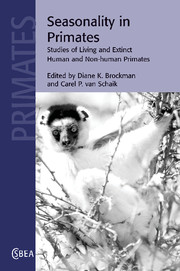Book contents
- Frontmatter
- Contents
- List of contributors
- Preface
- Part I Introduction
- Part II Seasonal habitats
- Part III Seasonality and behavioral ecology
- Part IV Seasonality, reproduction, and social organization
- Part V Seasonality and community ecology
- Part VI Seasonality and human evolution
- 17 Tropical and temperate seasonal influences on human evolution
- 18 Orbital controls on seasonality
- 19 What do studies of seasonality in primates tell us about human evolution?
- Index
- References
17 - Tropical and temperate seasonal influences on human evolution
Published online by Cambridge University Press: 10 August 2009
- Frontmatter
- Contents
- List of contributors
- Preface
- Part I Introduction
- Part II Seasonal habitats
- Part III Seasonality and behavioral ecology
- Part IV Seasonality, reproduction, and social organization
- Part V Seasonality and community ecology
- Part VI Seasonality and human evolution
- 17 Tropical and temperate seasonal influences on human evolution
- 18 Orbital controls on seasonality
- 19 What do studies of seasonality in primates tell us about human evolution?
- Index
- References
Summary
Introduction
Climatic and subsequent habitat change has often been invoked as a driving force of evolutionary change in hominins, mammals, and other taxa (Vrba 1988a, 1988b, 1992, 1995; Bromage & Schrenk 1999; Potts 1998; Bobe & Eck 2001; Janis et al. 2002). Global climatic change in the mid Pliocene Epoch has been suggested as a cause for hominin speciation events (Vrba 1995) and is correlated with changes in dentition and jaw morphology of two hominin lineages (Teaford & Ungar 2000). Climatic change also influences seasonality, such that drying trends, for example, likely instigate short wet seasons, while the reverse is also true. Although Foley (1987) indicated that seasonal differences were likely important in determining hominin foraging effort, and Blumenschine (1987) posited a dry-season scavenging niche for Pleistocene hominids, little attention has been given to how seasonal changes over time might contribute to differences among hominin behavioral adaptations. Seasonal changes refer to changes in the lengths of regular four-season patterns in temperate climates or wet and dry seasonal differences in the tropics over geological time.
Evolutionary changes in fossil hominins are detected through changes in morphology that represent different behavioral adaptations. Fossil hominin diets are inferred from comparisons with extant primates in features such as tooth size (Hylander 1975; Kay 1984; Ungar & Grine 1991), molar shearing crests (Kay 1984), dental microwear (Grine 1981; Teaford 1988; Ungar 1998), biomechanics (Hylander 1988; Daegling & Grine 1991), and isotopic signatures (Sponheimer & Lee-Thorp 1999; van der Merwe et al. 2003).
- Type
- Chapter
- Information
- Seasonality in PrimatesStudies of Living and Extinct Human and Non-Human Primates, pp. 489 - 518Publisher: Cambridge University PressPrint publication year: 2005
References
- 3
- Cited by



